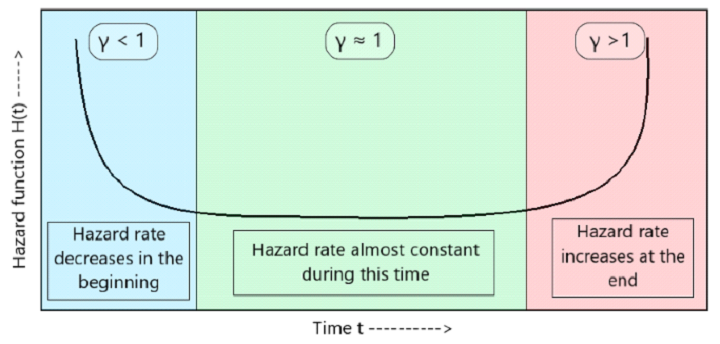
 Data Structure
Data Structure Networking
Networking RDBMS
RDBMS Operating System
Operating System Java
Java MS Excel
MS Excel iOS
iOS HTML
HTML CSS
CSS Android
Android Python
Python C Programming
C Programming C++
C++ C#
C# MongoDB
MongoDB MySQL
MySQL Javascript
Javascript PHP
PHP
- Selected Reading
- UPSC IAS Exams Notes
- Developer's Best Practices
- Questions and Answers
- Effective Resume Writing
- HR Interview Questions
- Computer Glossary
- Who is Who
What is the Weibull Hazard Plot in Machine Learning?
The cumulative hazard plot is a graphical representation that helps us understand the reliability of a model fitted to a given dataset. Specifically, it provides insights into the expected time of failure for the model.
The cumulative hazard function for the Weibull distribution describes the accumulated risk of failure up to a specific period. In simpler terms, it indicates the amount of risk that has accumulated through time, indicating the possibility of an event occurring beyond that point.
We can learn a lot about the failure pattern and behaviour of the object under study by looking at the cumulative hazard plot. It enables us to analyse the model's reliability and make predictions regarding the timing of future breakdowns.
What is the Weibull Distribution?
To investigate item or event dependability and failure patterns, a mathematical model known as the Weibull distribution might be utilised. The hazard function describes the likelihood of a future event occurring. Let me give an example to demonstrate this notion further.
Consider a torch that has been in use for the time provided, "t." The hazard function now enables us to calculate the likelihood that the torch will fail within a brief window of time, say between t and t + dt hours of operation. The Weibull hazard function provides the probability in question. We can see how the torch's danger function looks if we look at the Weibull hazard plot. In this instance, the hazard function is defined by the equation H(t) = (t/), where and are Weibull distribution-specific parameters.
It's important to keep in mind that modifications to the Weibull distribution's shape parameter () have an effect on the hazard function as well. Different hazard functions, which represent different degrees of danger or failure probability, may be produced by different values of. In conclusion, the Weibull hazard function enables us to comprehend the likelihood that an event will take place at a specific point in the future. We may learn more about the dependability and failure patterns of things or occurrences by looking at the hazard plot, which can be helpful for anticipating and controlling risks.
What is the Weibull Hazard Plot in Machine Learning?
The Weibull Hazard Plot is a graphical depiction used in machine learning to assess the effectiveness and dependability of a model that works with time-to-event or survival data. It aids in our comprehension of how actions or failures develop over time. Let's take a hypothetical situation where we are trying to estimate when a certain event will occur in order to further explain. For instance, it can be the amount of time left until a machine breaks down or a consumer leaves. The Weibull distribution is frequently used to simulate the time to occur in such circumstances.
The hazard function connected to the fitted Weibull model is shown graphically in the Weibull Hazard Plot. Time is often plotted on the x-axis while the hazard function is plotted on the y-axis. The danger or likelihood that the event will occur at a specific moment is described by the hazard function. We may learn more about how the risk or failure rate evolves over time in accordance with the fitted Weibull model by analyzing the contour and pattern of the curve in the graphic. Understanding the behavior and properties of the data is made easier with the use of this information.

We may compare several models or gauge how various factors affect the danger function using the Weibull danger Plot. Based on the fitted Weibull distribution, it also helps in making predictions about when potential future occurrences or failures could occur. In conclusion, the Weibull Hazard Plot is a useful machine learning tool that aids in the visualization and analysis of survival data. It makes it possible for academics and industry professionals to decide with knowledge about risk, dependability, and the timing of occurrences or model failures.
Python Example of Weibull
import numpy as np
import matplotlib.pyplot as plt
from scipy.stats import weibull_min
# Generate Weibull-distributed random data
shape = 2.5
scale = 50
data = weibull_min.rvs(shape, scale=scale, size=100)
# Sort the data in ascending order
sorted_data = np.sort(data)
# Compute the cumulative probability (CDF)
cdf = np.arange(1, len(sorted_data) + 1) / len(sorted_data)
# Compute the survival probability
survival_prob = 1 - cdf
# Create the Weibull plot
plt.figure(figsize=(8, 6))
plt.plot(sorted_data, cdf, marker='o', linestyle='-', label='Weibull Plot')
plt.xlabel('Time')
plt.ylabel('Cumulative Probability')
plt.title('Weibull Plot')
plt.legend()
plt.grid(True)
plt.show()
# Compute the hazard function
hazard = np.gradient(-np.log(survival_prob), sorted_data)
# Create the Weibull hazard plot
plt.figure(figsize=(8, 6))
plt.plot(sorted_data, hazard, marker='o', linestyle='-', color='r', label='Weibull Hazard Plot')
plt.xlabel('Time')
plt.ylabel('Hazard Function')
plt.title('Weibull Hazard Plot')
plt.legend()
plt.grid(True)
plt.show()
Weibull distribution-based random data is initially produced in this example using the 'weibull_min.rvs()' method from the'scipy.stats' package. Next, we compute the cumulative probability (CDF) and survival probability after sorting the data in ascending order.
Weibull plot is the first plot, produced by 'plt.plot()'. On the x-axis are the sorted data, and on the y-axis is the cumulative probability. Using 'plt.show()', both charts are shown. Labels, titles, gridlines, colours, and other plot parameters may be changed to further suit your needs in order to further personalize the plot's appearance.

